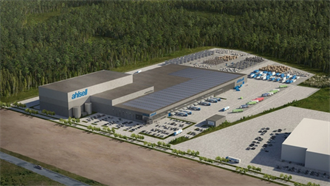When prime rents for warehouse properties in London last year overtook markets including Hong Kong, San Francisco, Singapore and Geneva, it marked a clear sign of the times for the island nation.
UK rents in the sector had been rising the fastest of any in Europe, with spikes in excess of 10% in West London, and double-digit growth forecast for the capital in the years ahead. Now, with lingering, pandemic-era issues, Brexit and the war in Ukraine redoubling occupational pressures, plus the ongoing growth of e-commerce requirements, it seems likely that prime rents are heading higher than even optimistic estimates.
While many of the UK’s logistics landlords find themselves in an outstanding position in terms of income, the rigidity of market supply implies there could yet be trouble.
‘Occupiers are now having to head to non-optimal logistics locations,’ says Bruce Robertson, head of supply chain and consumer advisory at CBRE. ‘Ten years ago, they could have relocated to the Golden Triangle in the Midlands, but land is simply running out.’ While for some of the latest nearshoring requirements, strategic locations may become less vital, there are still plenty of occupiers who require very specific positioning to manage complex distribution trade.
However, news that Associated British Ports (ABP) has recently brought forward 1,000 acres (400 ha) of development land for the supply chain, manufacturing and renewable energy sectors suggests there is some light at the end of the tunnel. The UK’s largest port operator, which has 21 ports around the country, is making 14 strategic sites available for a range of businesses, in the first wave of an initiative which will also, in part, facilitate the UK government’s ‘freeport’ plans.
According to ABP’s CEO Henrik L. Pedersen: ‘Our ports – with their superb connectivity both domestic and internationally, together with established infrastructure – already play a key role in the UK manufacturing, supply chain and energy sectors. This initiative will enable a growing number of businesses to leverage our land, property partnering expertise and power capacity. We believe this can make a significant contribution to the country’s economic vibrancy and supply chain efficiency.’
A first tranche of 14 sites was unveiled at the end of last year, including Cardiff, Immingham, Newport, Port Talbot, Southampton and Hull, with further opportunities set to be announced later in 2022.
Rethinking strategic locations
ABP in total manages around 12,500 acres of land and water across its UK ports. It reckons that around 2,400 acres in total has development potential, of which 1,100 acres were released in the first tranche last November.
While the announcement has already generated plenty of interest, ABP realises that a part of its task involves convincing occupiers and landlords who have hitherto focused on the Golden Triangle or the South East – in the centre of England’s land mass – that coastal areas can not only play a strategic role but could prove even more cost effective. While all locations benefit from rail and road connectivity plus renewable energy generation, over the next year or so, ABP is spending more than £5 mln (€5.9 mln) to make the sites ready for development, obtain appropriate outline planning consents, and bring forward technical understanding and land preparation.
Says Huw Turner, ABP’s group head of property: ‘ABP has always supported occupiers around port-based manufacturing, but we realised a few years ago that we weren’t necessarily being so proactive in terms of driving those benefits up front. Now, securing outline consents where possible helps de-risk our land in terms of time and costs. By helping with the key site selection criteria, we give occupiers certainty around when they can occupy the sites, as well as allowing them to factor in aspects such as labour and decarbonisation drives.’
Occupiers are already expressing an interest in the sites. Turner reports: ‘We’ve just completed a new-build factory for a plaster board manufacturer which imports raw materials and will manufacture the product on site before distributing it across the UK and continental Europe’.
According to media reports, Amazon is believed to have offered to take almost all the development space at the port of Cardiff in Wales, which amounts to some 36 acres. While ABP has not confirmed or denied the rumour, the deal would potentially tie up with recent news that the UK government intends to greenlight a freeport in Wales. A freeport prospective for the region is expected to be published this summer, before bids for the exact locality are evaluated.
Freeport benefits
The freeport dimension is particularly important for occupiers across all aspects of the import-export trade, as they allow the tax-free handling of goods or components which aren’t destined for UK internal markets. So far, freeport status has been designated in parts of ABP’s Southampton and Humber ports.
Turner reports: ‘Our sites are attracting interest many Asian manufacturers. They see an opportunity to assemble products from imported components in a freeport, obtain ‘made in the UK’ badges, while mitigating import-export duties and benefitting from tax breaks including plus access to labour.
‘We find that our ports are generally well-placed in terms of labour supply, compared to the typical logistics hotspots,’ Turner adds. ‘ABP runs the electrical power network in port sites, so we have an opportunity to provide behind-the-meter embedded generation. We have a track record in wind turbines and solar, and are looking at energy storage and turnkey build-to-suit solutions in this area, so we can further support customers.’
Still on the energy topic, ABP tenants include leaders in off-shore wind power, such as Siemens Gamesa Renewable Energy, which has launched a £310 mln state-of-the-art production and assembly facility in the port of Hull. Huw Turner explains: ‘Port Talbot, meanwhile, has some of the deepest water and ship acceptance criteria in the UK – attributes which lend themselves to supporting the floating offshore wind sector. It’s also an area where there are good employment demographics in terms of skills from the steelworks and industrial hinterland.’
The occupier argument
Notes CBRE’s Robertson: ‘Part of my role is advising occupiers where they should be located, at the interface between supply chains and real estate. What we have found is that port sites also make sense geographically. While many occupiers have traditionally headed for the centre of the country to create a hub and spoke model for distribution, that’s not always the shortest route to the customer. For example, if you’re importing a lot, it can make much more sense to be based at the port and distribute from there, particularly if you are then manufacturing products and transporting them on.’
Robertson confirms ABP’s dataset around labour as well, a key issue for logistics occupiers today. ‘These days, some occupiers are choosing sites almost wholly on the question of labour availability, and the ABP sites enjoy very good metrics on that front, often due to the industrial heritage of the locations. Essentially, we are finding that landlord and occupier considerations around workforce, land availability and logistics costs are all dovetailing around these sites.’



































